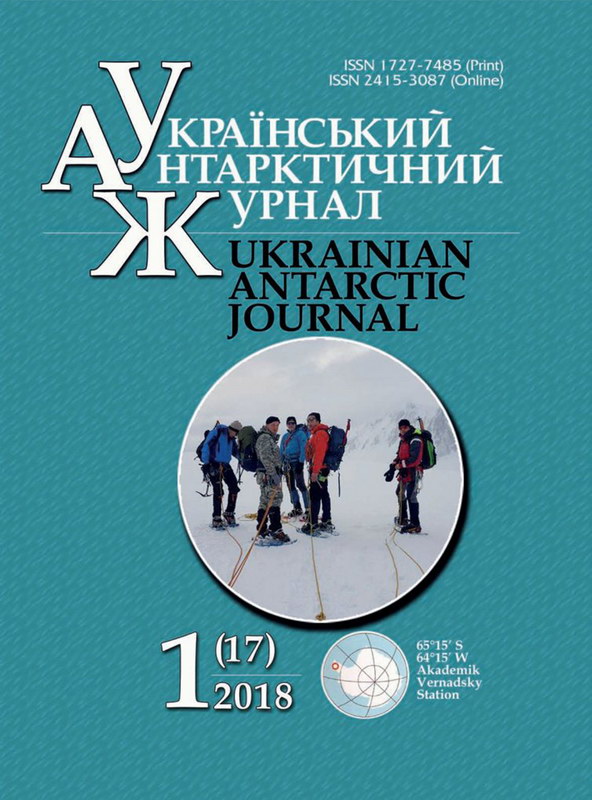- total ozone,
- Vernadsky Antarctic station,
- Dobson spectrophotometer,
- satellite measurements,
- data comparison

This work is licensed under a Creative Commons Attribution-NonCommercial-NoDerivatives 4.0 International License.
Abstract
Objective. Provide an analysis of the total ozone variations over Vernadsky Antarctic station (Faraday Base until 1996) from long-term ground-based and satellite series. Study the discrepancies between the data of different instruments. Methods. Data visualization followed by analysis, statistical treatment of the Vernadsky Dobson spectrophotometer observations and satellite total ozone series. Results. Satellite and ground-based measurements of total ozone over Vernadsky station have confirmed the stabilization in the ozone layer in the stratosphere over Antarctica from the early 2000s. British Faraday Base observations have retrieved an ozone spring maximum during the 1950s–1970s with a sharp decrease in the August–October values in the 1980s–1990s. That changed substantially total ozone seasonal cycle. Satellite overpasses and model data based on satellite measurements have been analyzed. It is shown that typical discrepancies between the Ozone Monitoring Instrument (OMI) model and the Vernadsky Dobson daily means are mainly in the range of 20 DU. Larger deviations are rare and are observed predominantly on the beginning and at the end of the observational season. Seasonal means and standard deviations for the model–Dobson differences were calculated that demonstrates worse correspondence of the OMI model with Vernadsky Dobson data during separate years, in particular 2009–2010. Conclusions. Both Dobson and satellite ozone data over Faraday/Vernadsky station have shown the total ozone decrease during the 1980s–1990s (mainly in spring) with a following stabilization since year 2000. Comparison between the ground-based data and models calculated from satellite measurements indicates better correspondence of the Dobson and GOME2 results relatively the OMI ones. There are evidences that individual Dobson measurements underestimate to some degree total ozone on the beginning of observational season at high solar zenith angles and the low total ozone values.
References
- Basher, R. E. 1982. Review of the Dobson Spectrophotometer and its accuracy. Springer Netherlands, 387-391. https://doi.org/10.1007/978-94-009-5313-0_78
- Chipperfield, M. P., Bekki, S., Dhomse, S., Harris, N. R. P., Hassler, B., Hossaini, R., Steinbrecht, W., Thiéblemont, R., and Weber, M. 2017. Detecting recovery of the stratospheric ozone layer. Nature, 549(7671), 211. https://doi.org/10.1038/nature23681
- Chipperfield, M. P., Dhomse, S., Hossaini, R., Feng, W., Santee, M. L., Weber, M., Burrows, J. P., Wild, J. D., Loyola, D., Coldewey-Egbers, M. 2018. On the cause of recent variations in lower stratospheric ozone. Geophysical Research Letters, 45. https://doi.org/10.1029/2018GL078071
- Eskes, H. J., Van Velthoven, P. F. J., Valks, P. J. M., and Kelder, H. M. 2003. Assimilation of GOME total-ozone satellite observations in a three-dimensional tracer-transport model. Quarterly Journal of the Royal Meteorological Society, 129(590), 1663-1681. https://doi.org/10.1256/qj.02.14
- Farman, J. C., Gardiner, B. G., and Shanklin, J. D. 1985. Large losses of total ozone in Antarctica reveal seasonal clox/nox interaction. Nature, 315(6016), 207. https://doi.org/10.1038/315207a0
- Fioletov, V. E., Labow, G., Evans, R., Hare, E. W., Köhler, U., McElroy, C. T., Miyagawa, K., Redondas, A., Savastiouk, V., Shalamyansky, A. M., et al. 2008. Performance of the ground-based total ozone network assessed using satellite data. Journal of Geophysical Research: Atmospheres, 113(D14). https://doi.org/10.1029/2008JD009809
- Gottwald, M., H., Bovensmann, G., Lichtenberg, S., von Bargen S., N. A., Slijkhuis, A., Piters, R., von Savigny M., H. C., Buchwitz, A., Kokhanovsky, A., Richter, A., Rozanov, T., Holzer-Popp, K., J.-C., B., Lambert, J., Skupin, F., Schrijver, W. H., and Burrows, J. 2006. SCIAMACHY, monitoring the changing earth's atmosphere, German Aerospace Center (DLR), Remote Sensing Institute (IMF), Report No. 167.
- Grytsai, A. V., Evtushevsky, O. M., Agapitov, O. V., Klekociuk, A. R., and Milinevsky, G. P. 2007. Structure and long-term change in the zonal asymmetry in Antarctic total ozone during spring. Annales Geophysicae, 25(2), 361-374. https://doi.org/10.5194/angeo-25-361-2007
- Grytsai, A., Klekociuk, A., Milinevsky, G., Evtushevsky, O., and Stone, K. 2017. Evolution of the eastward shift in the quasi-stationary minimum of the Antarctic total ozone column. Atmospheric Chemistry and Physics, 17(3), 1741-1758. https://doi.org/10.5194/acp-17-1741-2017
- Grytsai, A. and Milinevsky, G. 2013. SCIAMACHY/Envisat, OMI/Aura, and ground-based total ozone measurements over Kyiv-Goloseyev station, International Journal of Remote Sensing, 34(15), 5611-5622. https://doi.org/10.1080/01431161.2013.794988.
- Ialongo, I., Sofieva, V., Kalakoski, N., Tamminen, J., and Kyroa, E. 2012. Ozone zonal asymmetry and planetary wave characterization during Antarctic spring. Atmospheric Chemistry and Physics, 12(5), 2603-2614. https://doi.org/10.5194/acp-12-2603-2012.
- Kravchenko, V., Evtushevsky, A., Grytsai, A., Milinevsky G., and Shanklin, J. 2009. Total ozone dependence of the difference between the empirically corrected EP-TOMS and high-latitude station datasets, International Journal of Remote Sensing, 30:15-16, 4283-4294, https://doi.org/10.1080/01431160902825008.
- Kuttippurath, J., Lefevre, F., Pommereau, J.-P., Roscoe, H. K., Goutail, F., Pazmino, A., and Shanklin, J. D. 2013. Antarctic ozone loss in 1979-2010: first sign of ozone recovery. Atmospheric Chemistry and Physics, 13(3), 1625-1635. https://doi.org/10.5194/acp-13-1625-2013.
- Redondas A., Evans R., Stuebi R., et al. 2014. Evaluation of the use of five laboratory-determined ozone absorption cross sections in Brewer and Dobson retrieval algorithms. Atmospheric Chemistry and Physics, 14, 1635-1648. https://doi.org/10.5194/acp-14-1635-2014
- Siddaway, J. M., Petelina, S. V., Karoly, D. J., Klekociuk, A. R., and Dargaville, R. J. 2013. Evolution of antarctic ozone in september-december predicted by ccmval-2 mo del simulations for the 21st century. Atmospheric Chemistry and Physics, 13(8), 4413-4427. https://doi.org/10.5194/acp-13-4413-2013
- Solomon, S. 1999. Stratospheric ozone depletion: A review of concepts and history. Reviews of Geophysics, 37(3), 275-316. https://doi.org/10.1029/1999RG900008.
- Stolarski, R. S., Krueger, A. J., Schoeberl, M. R., McPeters, R. D., Newman, P. A., and Alpert, J. C. 1986. Nimbus 7 satellite measurements of the springtime Antarctic ozone decrease. Nature, 322(6082), 808-811. https://doi.org/10.1038/322808a0.
- Veefkind, J. P., de Haan, J. F., Brinksma, E. J., Kroon, M., and Levelt, P. F. 2006. Total ozone from the ozone monitoring instrument (OMI) using the DOAS technique. IEEE Transactions on Geoscience and Remote Sensing, 44(5), 1239-1244. https://doi.org/10.1109/TGRS.2006.871204.
- Waugh, D. W. and Randel, W. J. 1999. Climatology of Arctic and Antarctic polar vortices using elliptical diagnostics. Journal of the Atmospheric Sciences, 56(11), 1594-1613. https://doi.org/10.1175/1520-0469(1999)056<1594:COAAAP>2.0.CO;2

